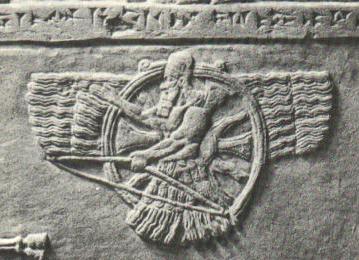Ancient Psychedelia: Alien Gods & Mushroom Goddesses
Online Book - Chapter 8, Page 118
Back to Online Book Mainpage / Next Page (Chapter 8, Page 119)
| Utu (Sumer) Shamash (Babylonian/Akkad) was the brother of Inanna-Ishtar. As the dream-god or oracle-god, he is bel-biri the “Lord of Visions.” (80) He was often invoked for healing, to prolong life with his name appearing frequently in incantations for the sick. (81) Utu is usually depicted on Sumerian tablets as holding what looks like a primitive ankh before a kind of “orb” sitting on a table. The gender of Shamash is something that is not clear to historians and there is some debate. Shapath or Shemesh was a Canaanite goddess of the sun and daughter of El and Asherah. She was sometimes confused or intermingled with Shamash, (82) which may happen with translations or when someone wants to change a she into a he intentionally. Shamash is still considered a female deity by some scholars and historians. (83) Though s/he is always associated with the sun, I’m not so sure Shamash was ever a sun god/dess. S/he was a bringer of light. The temple at Larsa in the south and Nippur in the north was called E-babbar which means “House of Lustre” or light. (84) However, this does not imply the sun necessarily and this may be a long-time case of “mistaken identity.” (S)he was also known as a judge of the dead in the underworld, like Osiris and was also responsible for transmitting the Law to Hammurabi. (85) In doing my research I found cases where Ashi was given the qualities of “celibacy” but when investigated closely, celibacy was never mentioned, only “purity” which indicates cleanliness, which is nothing at all like celibacy, but could easily be mixed up and interchanged by patriarchal minds. The same may have happened in relation to “light” or “lustre” and the sun. We should keep in mind, the stories and the images we see on steles and figurines are not always synchronized in time. We may have stories of Utu, as a sun god or solar deity, and this may be linked also to Shamash, but the images we have (21a, b) depict “him” (since he has a beard in this case), with a bow and arrow, inside of an orb with spokes, and wings, indicating his flight. The arrow is a symbol for rain as we learned and also mushrooms. The bow and arrow has no connection to the sun whatsoever, only to rain and storms.  (21a) Ashur / Shamash c. 900-800 BC |
(21b) Ashur / Shamash North-West Palace of Ashurnasirpal II at Nimrud c. 865-850 BC The role of prayers and incantations to the gods and prayers for relief of illness were probably the original reasons for appealing to the gods in the first place. Maintenance of health was virtually unknown in the very beginning of time, for all humans. Most likely, one of the earliest health applications realized by the more spiritually enlightened was the restraint of eating meat. Other than that, taking healing herbs and mushrooms as a curative was the only “healthy” idea people appear to have had. In the early Mesopotamian period, several gods were appealed to for divine aid, as we read in this ancient healing prayer: “When [I] enter the house, Shamash is before me, Sin is behind [me], Nergal is at [my] right hand, Ninib is at my left hand; when I draw near unto the sick man, when I lay my hand on the head of the sick man, may a kindly spirit, may a kindly guardian angel stand at my side! Whether thou art an evil spirit or an evil demon, or an evil ghost, or an evil devil, or an evil god, or an evil fiend, or sickness, or death, or phantom of the night, or wraith of the night, or fever, or evil pestilence, be though removed from before me, out of the house go forth! [For] I am the sorcerer-priest of Ea, it is I who [recite] the incantation for the sick man. (86) Pazuzu was the king of the demons of the wind, brother of Humbaba and son of the god Hanbi. He also represented the southwestern wind, the bearer of storms and drought. (87) Pazuzu could be invoked against his rival Lamashtu (14c). At least that is what some scholars have written. However, in imagery, both Pazuzu and Lamashtu appear as the same deity, and they are described as the same as well. (80) American Journal of Semitic Languages, Vol. 35, Oct. 1918-July 1919, p. 146 (81) Jastrow, Civilization, p. 246; also see Zimmern, in ERE ii, 311 (82) Johnston, Sarah Isles, Religions of the Ancient World: A Guide. Cambridge: Harvard University Press. P. 418 (83) Before the Bible, p. 130; Wyatt, Nick, There's Such Divinity Doth Hedge a King, Ashgate (19 Jul 2005), ISBN 978-0-7546-5330-1, p. 104 (84) Healing Gods, p. 127 (85) https://www.britannica.com/topic/Shamash (86) Healing Gods, p. 108-09; Thompson, Devils and Evil Spirits of Babylonia, i, 15 (87) https://en.wikipedia.org/wiki/Pazuzu |
Go Back to Page 117